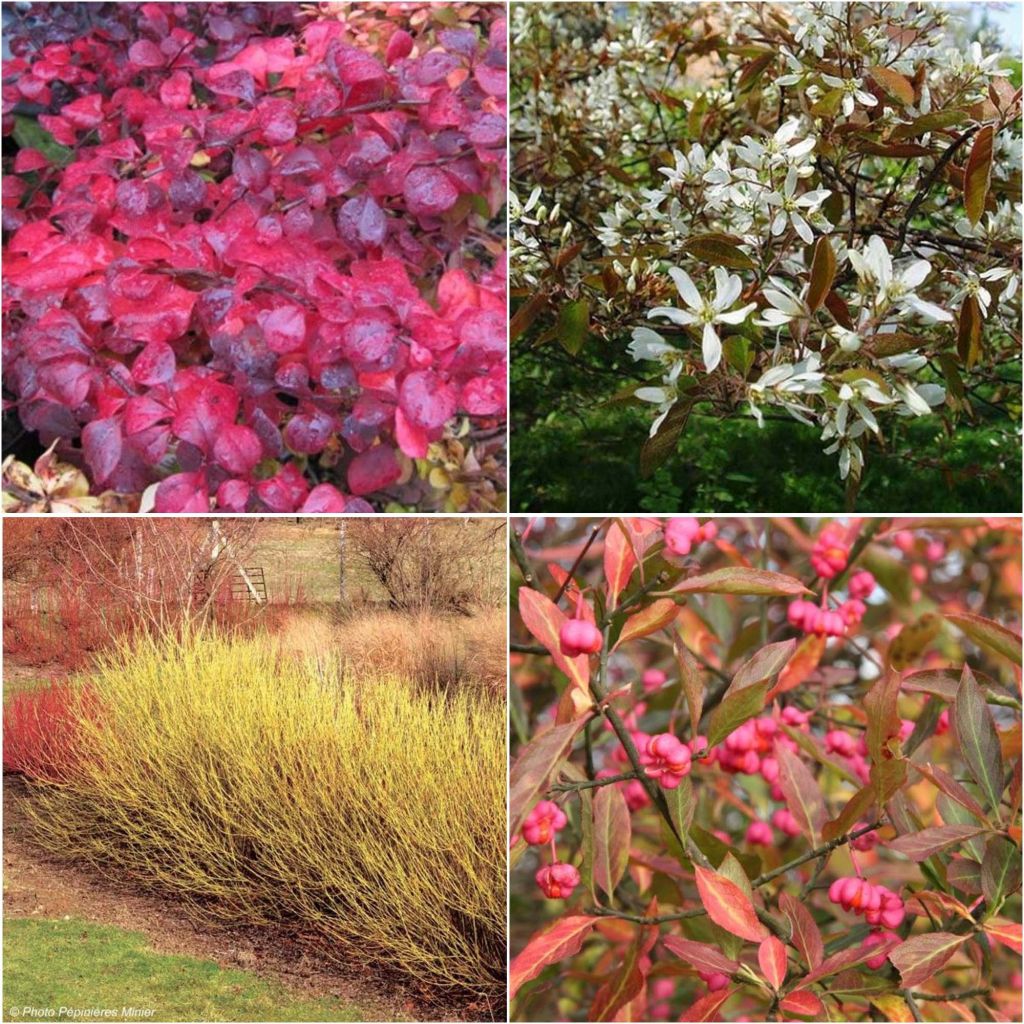Shipping country and language
Your country of residence may be:
Your country of residence is:
For a better user experience on our website, you can select:
Your shipping country:
Andorra
Austria
Belgium
Bulgaria
Canada
Chile
Croatia
Cyprus
Czechia
Denmark
Estonia
Finland
France
Germany
Greece
Hungary
Iceland
Ireland
Italy
Latvia
Lithuania
Luxembourg
Malta
Monaco
Netherlands
Poland
Portugal
Romania
Slovakia
Slovenia
Spain
Sweden
Switzerland
United Kingdom
We only deliver seed and bulb products to your country. If you add other products to your basket, they cannot be shipped.
Language:
French
German
Spanish
English
My Account
Hello
My wish lists
Plantfit
Log in / Register
Existing customer?
New customer?
Create an account to track your orders, access our customer service and, if you wish, make the most of our upcoming offers.


Four Seasons Eco Wild Hedge Kit
Four Seasons Eco Wild Hedge Kit
Order in the next for dispatch today!
Dispatch by letter from €3.90.
Delivery charge from €5.90 Oversize package delivery charge from €6.90.
More information
This item is not available in your country.
Schedule delivery date,
and select date in basket
This plant carries a 24 months recovery warranty
More information
We guarantee the quality of our plants for a full growing cycle, and will replace at our expense any plant that fails to recover under normal climatic and planting conditions.
From €5.90 for pickup delivery and €6.90 for home delivery
Express home delivery from €8.90.
Does this plant fit my garden?
Set up your Plantfit profile →
Collection items (20 plants)
Description
Four varieties of wild bushes are easy to grow and maintain, making a natural hedge that will remain attractive throughout the year. Perfect for quickly creating a changing green screen throughout the seasons, these bushes will blend into the landscape while promoting biodiversity in the garden. A kit of 20 pot plants allows you to create approximately 20 metres of a wild hedge.
The kit consists of:
- 5x Berberis thunbergii 'Atropurpurea': approximately 1.50 metres in height and width. Bushy and rounded habit. The branches of the bush have non-aggressive thorns. Flowering in April-May, clusters of small pale yellow bells dotted with red, followed by small spherical red fruits in September-October. Deciduous reddish-purple foliage, turning bright red in autumn. It creates a beautiful contrast with the flowers.
- 5x Amelanchier lamarckii: approximately 4 metres in height and 2 metres in width. Bronze, then dark green, and finally red deciduous foliage, covered with white flowers and producing juicy and sweet fruits. A fast-growing, hardy, open, rounded, compact, light, and graceful small tree.
- 5x Euonymus europaeus: approximately 2.50 metres in height and 2 metres in width. This modest-sized bush provides us with beautiful autumn colours. Its deciduous green leaves are adorned with striking shades of red, Indian pink, and purple before falling. It is also covered with small (toxic) fruits of bright and original colours: their pink capsules reveal bright orange berries.
- 5x Cornus stolonifera Flaviramea: approximately 2 metres in height and width. Very fast-growing. Recognisable by its bright yellow wood in winter, it will bring colour to your garden when other plants are dormant. Spring flowering in small clusters of discreet white flowers. The foliage that appears in spring is a deep green.
Plant these bushes, preferably in autumn or early spring, in full sun or partial shade, mixing them and spacing them about 1 metre apart. They are content with well-prepared garden soil, even limestone, and have been improved with leaf compost to help them establish. Once well-established, they do not require watering in summer. A hedge planted 2 metres from the property boundary should not exceed 2 metres in height.
Advice: Do not prune at the beginning of the season to fully enjoy the flowering! If possible, avoid pruning at the end of summer to enjoy the fruits and feed the garden birds in winter. Only intervene occasionally to limit the overcrowding of a bush, preferably after flowering.
Plant habit
Flowering
Foliage
Botanical data
Cultivar or hybrid
Planting and care
Plant in sun or part-shade, in ordinary (even chalky) but well-prepared soil enriched with leaf compost that is fairly cool but well-drained. Make planting holes 30-40 cm wide in all directions, breaking up the bottom and sides with a fork or pick. Keep a planting distance of about 1 m between each plant. Easy to grow and not very demanding, these shrubs only require mulching in summer in dry climates to maintain a certain humidity level, at least for the first few summers after planting. Water them abundantly in the first few years if there is a marked drought (15-20 litres of water each time) but at intervals. You can prune the longest branches to help your shrubs branch out. Avoid severe pruning, which compromises flowering, unless a shrub is getting too large.
Planting period
Intended location
Care
This item has not been reviewed yet - be the first to leave a review about it.
Haven't found what you were looking for?
Hardiness is the lowest winter temperature a plant can endure without suffering serious damage or even dying. However, hardiness is affected by location (a sheltered area, such as a patio), protection (winter cover) and soil type (hardiness is improved by well-drained soil).

Photo Sharing Terms & Conditions
In order to encourage gardeners to interact and share their experiences, Promesse de fleurs offers various media enabling content to be uploaded onto its Site - in particular via the ‘Photo sharing’ module.
The User agrees to refrain from:
- Posting any content that is illegal, prejudicial, insulting, racist, inciteful to hatred, revisionist, contrary to public decency, that infringes on privacy or on the privacy rights of third parties, in particular the publicity rights of persons and goods, intellectual property rights, or the right to privacy.
- Submitting content on behalf of a third party;
- Impersonate the identity of a third party and/or publish any personal information about a third party;
In general, the User undertakes to refrain from any unethical behaviour.
All Content (in particular text, comments, files, images, photos, videos, creative works, etc.), which may be subject to property or intellectual property rights, image or other private rights, shall remain the property of the User, subject to the limited rights granted by the terms of the licence granted by Promesse de fleurs as stated below. Users are at liberty to publish or not to publish such Content on the Site, notably via the ‘Photo Sharing’ facility, and accept that this Content shall be made public and freely accessible, notably on the Internet.
Users further acknowledge, undertake to have ,and guarantee that they hold all necessary rights and permissions to publish such material on the Site, in particular with regard to the legislation in force pertaining to any privacy, property, intellectual property, image, or contractual rights, or rights of any other nature. By publishing such Content on the Site, Users acknowledge accepting full liability as publishers of the Content within the meaning of the law, and grant Promesse de fleurs, free of charge, an inclusive, worldwide licence for the said Content for the entire duration of its publication, including all reproduction, representation, up/downloading, displaying, performing, transmission, and storage rights.
Users also grant permission for their name to be linked to the Content and accept that this link may not always be made available.
By engaging in posting material, Users consent to their Content becoming automatically accessible on the Internet, in particular on other sites and/or blogs and/or web pages of the Promesse de fleurs site, including in particular social pages and the Promesse de fleurs catalogue.
Users may secure the removal of entrusted content free of charge by issuing a simple request via our contact form.
The flowering period indicated on our website applies to countries and regions located in USDA zone 8 (France, the United Kingdom, Ireland, the Netherlands, etc.)
It will vary according to where you live:
- In zones 9 to 10 (Italy, Spain, Greece, etc.), flowering will occur about 2 to 4 weeks earlier.
- In zones 6 to 7 (Germany, Poland, Slovenia, and lower mountainous regions), flowering will be delayed by 2 to 3 weeks.
- In zone 5 (Central Europe, Scandinavia), blooming will be delayed by 3 to 5 weeks.
In temperate climates, pruning of spring-flowering shrubs (forsythia, spireas, etc.) should be done just after flowering.
Pruning of summer-flowering shrubs (Indian Lilac, Perovskia, etc.) can be done in winter or spring.
In cold regions as well as with frost-sensitive plants, avoid pruning too early when severe frosts may still occur.
The planting period indicated on our website applies to countries and regions located in USDA zone 8 (France, United Kingdom, Ireland, Netherlands).
It will vary according to where you live:
- In Mediterranean zones (Marseille, Madrid, Milan, etc.), autumn and winter are the best planting periods.
- In continental zones (Strasbourg, Munich, Vienna, etc.), delay planting by 2 to 3 weeks in spring and bring it forward by 2 to 4 weeks in autumn.
- In mountainous regions (the Alps, Pyrenees, Carpathians, etc.), it is best to plant in late spring (May-June) or late summer (August-September).
The harvesting period indicated on our website applies to countries and regions in USDA zone 8 (France, England, Ireland, the Netherlands).
In colder areas (Scandinavia, Poland, Austria...) fruit and vegetable harvests are likely to be delayed by 3-4 weeks.
In warmer areas (Italy, Spain, Greece, etc.), harvesting will probably take place earlier, depending on weather conditions.
The sowing periods indicated on our website apply to countries and regions within USDA Zone 8 (France, UK, Ireland, Netherlands).
In colder areas (Scandinavia, Poland, Austria...), delay any outdoor sowing by 3-4 weeks, or sow under glass.
In warmer climes (Italy, Spain, Greece, etc.), bring outdoor sowing forward by a few weeks.



